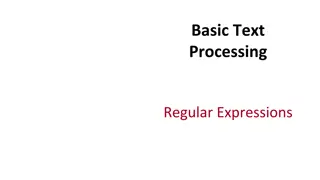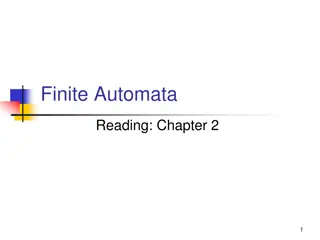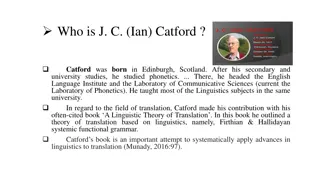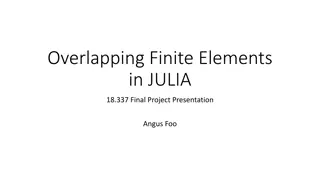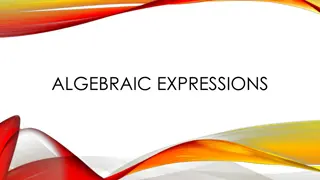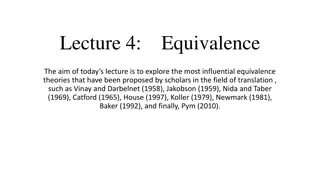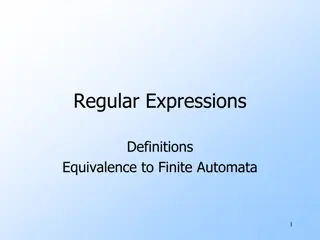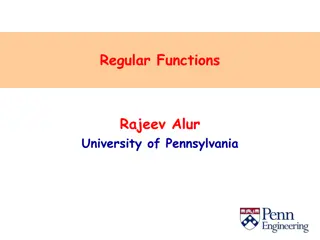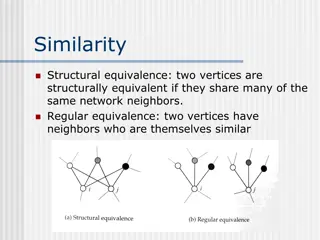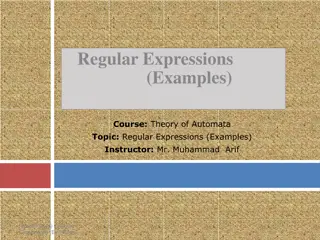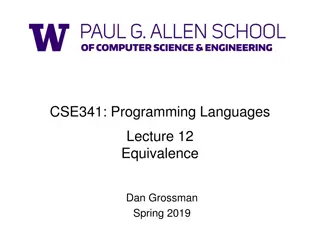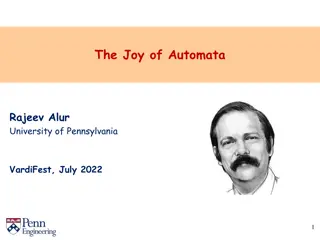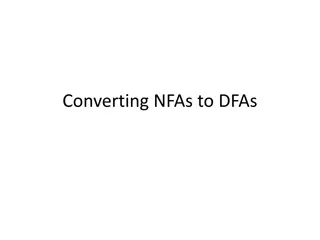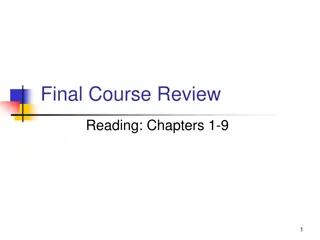Introduction to Regular Expressions and Equivalence to Finite Automata
Regular expressions (REs) are used to describe languages by algebra and are equivalent to finite automata. They define regular languages precisely using operations like union, concatenation, and Kleene star. The concatenation of languages combines strings from two languages, while the Kleene star represents zero or more occurrences of strings. Recursive definitions and basis of REs provide a foundation for understanding their induction and precedence of operators.
Download Presentation

Please find below an Image/Link to download the presentation.
The content on the website is provided AS IS for your information and personal use only. It may not be sold, licensed, or shared on other websites without obtaining consent from the author. Download presentation by click this link. If you encounter any issues during the download, it is possible that the publisher has removed the file from their server.
E N D
Presentation Transcript
Regular Expressions Definitions Equivalence to Finite Automata 1
REs: Introduction Regular expressions describe languages by an algebra. They describe exactly the regular languages. If E is a regular expression, then L(E) is the language it defines. We ll describe RE s and their languages recursively. 2
Operations on Languages RE s use three operations: union, concatenation, and Kleene star. The union of languages is the usual thing, since languages are sets. Example: {01,111,10} {00, 01} = {01,111,10,00}. 3
Concatenation The concatenation of languages L and M is denoted LM. It contains every string wx such that w is in L and x is in M. Example: {01,111,10}{00, 01} = {0100, 0101, 11100, 11101, 1000, 1001}. 4
Kleene Star If L is a language, then L*, the Kleene star or just star, is the set of strings formed by concatenating zero or more strings from L, in any order. L* = { } L LL LLL Example: {0,10}* = { , 0, 10, 00, 010, 100, 1010, } 5
REs: Definition Basis 1: If a is any symbol, then a is a RE, and L(a) = {a}. Note: {a} is the language containing one string, and that string is of length 1. Basis 2: is a RE, and L( ) = { }. Basis 3: is a RE, and L( ) = . 6
REs: Definition (2) Induction 1: If E1 and E2 are regular expressions, then E1+E2 is a regular expression, and L(E1+E2) = L(E1) L(E2). Induction 2: If E1 and E2 are regular expressions, then E1E2 is a regular expression, and L(E1E2) = L(E1)L(E2). Induction 3: If E is a RE, then E* is a RE, and L(E*) = (L(E))*. 7
Precedence of Operators Parentheses may be used wherever needed to influence the grouping of operators. Order of precedence is * (highest), then concatenation, then + (lowest). 8
Examples: REs L(01) = {01}. L(01+0) = {01, 0}. L(0(1+0)) = {01, 00}. Note order of precedence of operators. L(0*) = { , 0, 00, 000, }. L((0+10)*( +1)) = all strings of 0 s and 1 s without two consecutive 1 s. 9
Equivalence of REs and Finite Automata We need to show that for every RE, there is a finite automaton that accepts the same language. Pick the most powerful automaton type: the -NFA. And we need to show that for every finite automaton, there is a RE defining its language. Pick the most restrictive type: the DFA. 10
Converting a RE to an -NFA Proof is an induction on the number of operators (+, concatenation, *) in the RE. We always construct an automaton of a special form (next slide). 11
Form of -NFAs Constructed No arcs from outside, no arcs leaving Start state: Only state with external predecessors Final state: Only state with external successors 12
RE to -NFA: Basis Symbol a: a : : 13
RE to -NFA: Induction 1 Union For E1 For E2 For E1 E2 14
RE to -NFA: Induction 2 Concatenation For E1 For E2 For E1E2 15
RE to -NFA: Induction 3 Closure For E For E* 16
DFA-to-RE A strange sort of induction. States of the DFA are named 1,2, ,n. Induction is on k, the maximum state number we are allowed to traverse along a path. 17
k-Paths A k-path is a path through the graph of the DFA that goes through no state numbered higher than k. Endpoints are not restricted; they can be any state. n-paths are unrestricted. RE is the union of RE s for the n-paths from the start state to each final state. 18
Example: k-Paths 1 0-paths from 2 to 3: RE for labels = 0. 1 2 0 0 0 1-paths from 2 to 3: RE for labels = 0+11. 1 1 3 2-paths from 2 to 3: RE for labels = (10)*0+1(01)*1 3-paths from 2 to 3: RE for labels = ?? 19
DFA-to-RE Basis: k = 0; only arcs or a node by itself. Induction: construct RE s for paths allowed to pass through state k from paths allowed only up to k-1. 20
k-Path Induction Let Rijk be the regular expression for the set of labels of k-paths from state i to state j. Basis: k=0. Rij0 = sum of labels of arc from i to j. if no such arc. But add if i=j. 21
Example: Basis R120 = 0. R110 = + = . 1 1 2 0 Notice algebraic law: plus anything = that thing. 0 0 1 1 3 22
k-Path Inductive Case A k-path from i to j either: Never goes through state k, or Goes through k one or more times. Rijk = Rijk-1 + Rikk-1(Rkkk-1)* Rkjk-1. 1. 2. Goes from i to k the first time Then, from k to j Doesn t go through k Zero or more times from k to k 23
Illustration of Induction Path to k Paths not going through k i From k to k Several times j k From k to j States < k 24
Final Step The RE with the same language as the DFA is the sum (union) of Rijn, where: n is the number of states; i.e., paths are unconstrained. i is the start state. j is one of the final states. 1. 2. 3. 25
Example R233 = R232 + R232(R332)*R332 = R232(R332)* R232 = (10)*0+1(01)*1 R332 = + 0(01)*(1+00) + 1(10)*(0+11) R233 = [(10)*0+1(01)*1][ + (0(01)*(1+00) + 1(10)*(0+11))]* Start 1 1 2 0 0 0 1 1 3 26
Summary Each of the three types of automata (DFA, NFA, - NFA) we discussed, and regular expressions as well, define exactly the same set of languages: the regular languages. 27
Algebraic Laws for REs Union and concatenation behave sort of like addition and multiplication. + is commutative and associative; concatenation is associative. Concatenation distributes over +. Exception: Concatenation is not commutative. 28
Identities and Annihilators is the identity for +. R + = R. is the identity for concatenation. R = R = R. is the annihilator for concatenation. R = R = . 29
Decision Properties of Regular Languages General Discussion of Properties The Pumping Lemma Membership, Emptiness, Etc. 30
Properties of Language Classes A language class is a set of languages. Example: the regular languages. Language classes have two important kinds of properties: Decision properties. Closure properties. 1. 2. 31
Closure Properties A closure property of a language class says that given languages in the class, an operation (e.g., union) produces another language in the same class. Example: the regular languages are obviously closed under union, concatenation, and (Kleene) closure. Use the RE representation of languages. 32
Representation of Languages Representations can be formal or informal. Example (formal): represent a language by a RE or FA defining it. Example: (informal): a logical or prose statement about its strings: {0n1n | n is a nonnegative integer} The set of strings consisting of some number of 0 s followed by the same number of 1 s. 33
Decision Properties A decision property for a class of languages corresponds an algorithm that takes a formal description of a language (e.g., a DFA) and tells whether or not some property holds. Example: Is language L empty? 34
Why Decision Properties? Think about DFA s representing protocols. Example: Does the protocol terminate? = Is the language finite? Example: Can the protocol fail? = Is the language nonempty? Make the final state be the error state. 35
Why Decision Properties (2) We might want a smallest representation for a language, e.g., a minimum-state DFA or a shortest RE. If you can t decide Are these two languages the same? I.e., do two DFA s define the same language? You can t find a smallest. 36
The Membership Problem Our first decision property for regular languages is the question: is string w in regular language L? Assume L is represented by a DFA A. Simulate the action of A on the sequence of input symbols forming w. 37
Example: Testing Membership 0 1 0 1 1 Next symbol 0 0,1 1 1 A B C Start 0 Current state 38
Example: Testing Membership 0 1 0 1 1 Next symbol 0 0,1 1 1 A B C Start 0 Current state 39
Example: Testing Membership 0 1 0 1 1 Next symbol 0 0,1 1 1 A B C Start 0 Current state 40
Example: Testing Membership 0 1 0 1 1 Next symbol 0 0,1 1 1 A B C Start 0 Current state 41
Example: Testing Membership 0 1 0 1 1 Next symbol 0 0,1 1 1 A B C Start 0 Current state 42
Example: Testing Membership 0 1 0 1 1 Next symbol 0 0,1 1 1 A B C Start 0 Current state 43
What if We Have the Wrong Representation? There is a circle of conversions from one form to another: RE -NFA DFA NFA 44
The Emptiness Problem Given a regular language, does the language contain any string at all? Assume representation is DFA. Compute the set of states reachable from the start state. If at least one final state is reachable, then yes, else no. 45
The Infiniteness Problem Is a given regular language infinite? Start with a DFA for the language. Key idea: if the DFA has n states, and the language contains any string of length n or more, then the language is infinite. Otherwise, the language is surely finite. Limited to strings of length n or less. 46
Proof of Key Idea If an n-state DFA accepts a string w of length n or more, then there must be a state that appears twice on the path labeled w from the start state to a final state. Because there are at least n+1 states along the path. 47
Proof (2) w = xyz y x z q Then xyiz is in the language for all i > 0. Since y is not , we see an infinite number of strings in L. 48
Infiniteness Continued We do not yet have an algorithm. There are an infinite number of strings of length > n, and we can t test them all. Second key idea: if there is a string of length > n (= number of states) in L, then there is a string of length between n and 2n-1. 49
Proof of 2nd Key Idea y Remember: y is the first cycle on the path. So |xy| < n; in particular, 1 < |y| < n. Thus, if w is of length 2n or more, there is a shorter string in L that is still of length at least n. Keep shortening to reach [n, 2n-1]. x z 50



